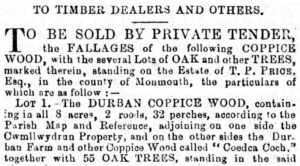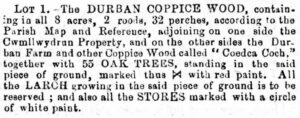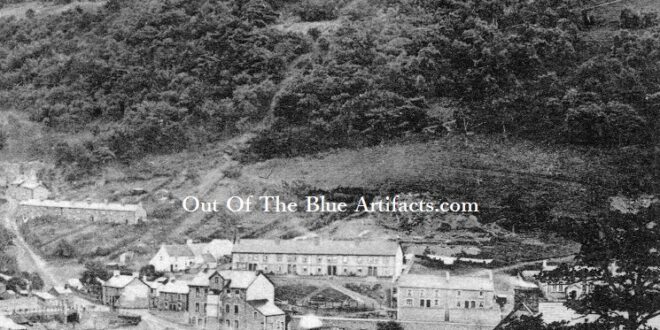Durban Level.
This coal level was situated on the western brow of the Pentre Parc Mountain, Brynhithel, overlooking Six Bells. Not a great deal is known of it, though it was developed and worked during the mid 19th century and was closed and abandoned fairly early.
Mrs Ann George.
On the 1840 tithe map, the land around where the level entrance was located was owned by Mrs Ann George, the occupier of the land was Mr Thomas Morgan, Mr Thomas Morgan was a farmer at Hafodarthen.
 Mr T. P. Price Esq.
Mr T. P. Price Esq.
A timber sales notice from the 1860’s (as seen left) shows that the land was owned by Mr T. P. Price Esq.
Mr T. P. Price may well have been Mr Thomas Prothero Price, who together with his brother Mr David Price owned the Tillery Colliery and its associated coal levels at Penybont and the Cwmnantygroes Levels at Six Bells. (More research is needed).
Durban Farm.
On Saturday 28th of November 1868, the Monmouthshire Merlin newspaper printed a notice of timber sales from coppice wood in the Parish of Llanhilleth. The wood was on the estate of T. P. Price Esq. Lot 1, was the Durban Coppice Wood, containing 8 acres, 2 roods, 32 perches. This land was said to have been adjoining on one side the Cwmllwydrun Property and on the other sides the Durban Farm and other Coppice Wood called Coedca Coch. Also close by was Craig yr Argoed.
The level was listed as operational in 1880 but not listed afterwards.
The tram road from the level came down the mountain into Six Bells village and under the main road near the old Post Office at Browns Corner and down to the railway lines for transport by rail. The waste was brought down the same tramway but diverted over the main line by a small rail-bridge and dumped on the ground where the Six Bells Colliery outbuildings and baths would later be built. A part of this waste tip was actually removed to be able to construct the Bethany Chapel.
The image above shows the level waste tips on the top of the mountain, the tramway, also the newly built Six Bells Hotel erected by Noel Bagley in 1892. Nestled under the black bridge, a tramway bridge, to take waste over the railway line from the levels, is the old Six Bells Inn besides a little row of cottages, now the site of an old age pensioners home.
Points of Interest – As to why this coal level was named Durban Level is a bit of a mystery, though in the late 1830’s and early 1840’s and later, the Boers clashed with the British over control of the port town of Durban, South Africa. The British were victorious and in 1854 Durban became a borough town. The proprietors of the Durban Level could have developed the level at this time and may well have named the level in remembrance of the conflicts and this occasion.
Durban Farm.
Also, as mentioned above, Durban was the given name to a farm in that area during the 1850’s and perhaps even earlier. Old maps shows a few buildings close to the level which doesn’t exist today but none of them named or listed in any paperwork.
 Out Of The Blue Artifacts A Library of a lifetime of collecting
Out Of The Blue Artifacts A Library of a lifetime of collecting
